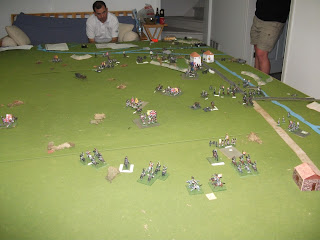On the other flank, Delaborde has almost destroyed the Portuguese but the British remain in control of the village, while Brennier remains rooted on the hill.
For the next two turns, little changed as both exhausted armies attempted to solidify their lines.
By the end of the game, it was clear that the British would not be able to exit a formed unit off the southern end of the battlefield. In this case, it would come down to casualties. These broke down as follows:
The French
Delaborde's Division
-Thomieres Brigade - 780
-Brennier's Brigade - 360
-Artillery - 60 (all in the train company)
Total: 1440
Loisin's Division
-Solignac's Brigade - 1020
-Artillery - 60
Total: 1080
Reserve Cavalry
-Margaron's Brigade - 360
-Maransin's Brigade - 60
Total: 420
French Total: 2940
The British
-20th Light Dragoons - all 180 were wiped out
-Hill's Brigade - 1470 (the 1/5th Foot was wiped out)
-Ferguson's Brigade - 630
-Nightingall's Brigade - 660
-Bowes Brigade - 480
-Crauford's Brigade - 480
-Fane's Brigade - 480
-Portuguese - 1080
-Reserve Artillery - 30 (the crew of the single 9lb were wiped out)
British Total: 5490
Given that almost one-in-three of the Allies was lost in the battle, this version of Rolica represents a tactical victory for the French. But with Junot still not in sight (apparently it was two for one at the mess the night before they left Lisbon...) and rumours abounding that the British were about to land troops at Vimiero in their rear, Delaborde got cold feet and gave the order to withdraw during the night. Wellesley was thus able to link up with his two remaining brigades. Meanwhile Junot, angered by Delaborde's unnecessary withdrawal from Rolica, would seek to strike back at the British quickly before the rest of Portugal rose up in revolt.





No comments:
Post a Comment